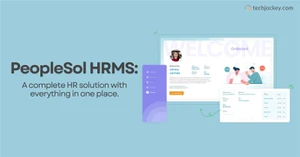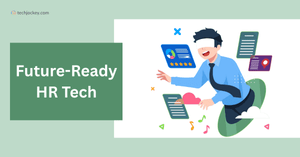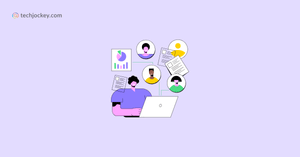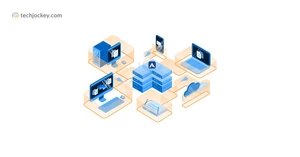What is HR Management Solutions Software?
HRMS Stands for a solution that assists organizations in tracking attendance, managing performance appraisals, payroll, workforce management, team management, leave management, etc. Businesses of all sizes can deploy HR & payroll management software to enhance productivity and employee engagement.
HR software is an automation tool for HR professionals and managers to manage a wide range of activities like recruitment, applicant tracking, talent retention, performance management, loans & reimbursements, succession planning, etc.
HRMS software is used interchangeably with HCM (human capital management) and HRIS (human resource information system). However, HRMS is a more comprehensive solution that helps manage the workforce and drives them towards higher engagement and productivity. While HRIS helps with payroll and benefits administration, HCM goes a step further in enabling learning & development strategies for employees.
The best HRMS software not only saves time and energy consumed in manual tasks but also reduces errors as well. With the help of the workforce management system software, companies can share information and update employee-related data quickly and easily.
What Does HR Software Solutions Do?
HR software enables businesses to automate and efficiently manage key tasks and processes related to the acquisition and management of employees like onboarding, payroll, attendance, performance tracking, appraisal, learning & development, etc.
HRIS or human resource information system stores critical company documents, employee records, training modules, and other related information in a centralized place for easy access. It also provides holistic insights into employee data and reduces the administrative burden.
How to Use HRMS Software?
- You can deploy HR management software on-premises or on the cloud. With successful HRMS implementation, your employees with getting access to the employee self-service portal where they can track and manage their tax, leaves, attendance, payslips, claims, and other details along with updating important documents.
- You can create user-based permission to access different HRMS modules, such as employee self-service portal for employees, recruitment portal for HR professionals, performance management portal for HR managers, and so on.
- You can also integrate your HR system with biometric machines for fingerprint or face recognition to track employee attendance automatically. The geo-tagging module of HR solutions is useful in tracking the attendance and location of your remote employees.
Categories of HR Software Solutions

HR Software is being categorized based upon its functionalities:
- Payroll Management Software: This payroll software helps businesses with the handling of employee salaries, loans, advances, reimbursement claims, etc. It provides real-time data and helps in calculating employees' salaries, bonuses, deductions, net pay, and generating payslips.
- Attendance Software: It keeps track of work hours while an employee is in the office or offsite. The attendance management software is often integrated with devices like smart cards, fingerprint scanners, and facial recognition biometric mechanisms.
- Leave Management Software: An application that streamlines the process of employees requesting and tracking their leaves. This leave management software also enables employers to easily and accurately allocate and approve leaves.
- Recruitment Management Software (RMS): An end-to-end software that helps manage and automate the recruiting and staffing operations. This RMS includes posting jobs, resume screening, and keeping applicants up to date with hiring processes till final recruitment.
- Applicant Tracking System: ATS tool that performs the collection, sorting, and analysis of job applications to filter out the best candidates based on an organization’s requirements.
- Workforce Management Software: The workforce management solution helps organizations plan, manage, and track employee-related work. This includes recruitment, onboarding, creating rosters and work schedules, issuing leave policies, and statutory compliant labor policies.
- Performance Management: The software helps organizations in establishing standards for activities and outputs and evaluating the performance of employees and departments against those standards.
- Benefits Administration: This solution helps in managing benefits information including that of medical insurance, retirement plans, life insurance, and disability insurance. It ensures compliance and enables workers to enroll in the system.
- Learning Management: Human resource management software helps with the creation of training courses and development programs for employees. This provides quick access to all learning tools and knowledge sharing for improving employee performance at jobs.
Types of HR Management Software
- Human resource information system (HRIS): HRIS is a type of HR software that has all the basic functions to plan and manage HR activities like payroll, tax compliance, benefits administration, employee self-service, time and attendance tracking, and reporting.
- Human Resource Management Systems (HRMS): HRMS is a comprehensive HR software that includes all features of HRIS along with recruitment, onboarding, performance management, learning & development.
- Human Capital Management (HCM): Along with HRIS and HRMS capabilities, HCM software also assists with applicant tracking, recruitment budgeting, absence management, succession planning, etc.
What are the Deployment Options for HR Software

- Cloud Hosted HRMS: Vendor hosts an organization’s instance of their HR software on their servers. The vendor is responsible for maintenance, backup, and security. The company access this on-demand or SaaS service on their system via a web browser, removing the need to deploy a server.
- On-Premise HRMS: In this on-site option, the organization is responsible for deploying and maintaining the HR software on their internal hardware system and servers. They need to ensure the minimum system requirements are met before installation and setup.
HR Management Software Modules & Integrations
- Attendance Biometric Device: The HRMS management system, when clubbed with the attendance biometric device, not only provides security but also makes sure that the attendance is accurately logged. The payroll management system verifies the employee through fingerprint and helps in restricting staff access in specific cabins or offices.
- Leave & Attendance Management System: With the HRMS system, employees can mark their attendance, monitor their duty hours, and apply for leaves.
- HR Payroll System: Besides getting detailed reports of the employee, the companies can ensure timely payments and track employee work hours through the HR Payroll System.
- Recruitment Management System: The HR management solution can be deployed to formulate hiring, and get important details about the candidate.
- Employees Performance Tracking System: Managing performance appraisal on a monthly or yearly basis becomes easier with HRIS software. Additionally, the managers can give quick feedback and performance ratings easily.
How Does Best Online HR Management Software Work
- HRMS software integrates and automates all major workforce management functions like employee lifecycle management, information management. It helps devise strategies and policies for higher employee engagement and productivity.
- HR Management System Software consists of self-service portals that help the employees with leave management, performance appraisal forms, payslips, and taxation details. Employees can access policy-related details through the employee self-service portal, apply for leaves, etc.
- At the same time, employers can ensure timely performance management and feedback along with devising learning & growth strategies to align an employee’s efforts with the organizational goals. Leave & attendance-related details can be tracked automatically for payroll processing and benefits administration.
Key Features of HRMS Software

- Employee and HR Database Management Solutions: This database management feature includes employees’ complete data like medical history, leave management, PPF and EPF forms, grievance history, and other pertinent information. Through HRMS, HR managers can access an employee’s records that are considered relevant for the organization.
- Leave & Attendance Management: HR management software helps track employee leave & attendance through the integration with fingerprint biometrics, face recognition, card swipes, etc.
- Candidate Application Tracker: The application tracker and management feature helps record and store the information of applicants, and segregate which one to select, and which one to reject. Also, you can conduct an applicant’s background check and bring efficiency to the onboarding process.
- Employee Document Management: This document management software feature ensures that all data and information relevant to the company and employees are maintained and managed efficiently. Company documents entail legal documents, yearly holiday lists, business documents, company policies, benefits, and insurance-related information.
- Task Management: With this feature of an HR management software solution, you can execute and manage a project effectively. With this, you can keep a track of project sheets, execute task management, team management, progress analysis, etc. HR management solution also allows you to track a project’s progress.
- Events Management: HRMS system helps the HR managers in performing their daily activities effectively. These daily tasks may comprise resource sharing, training schedules, reminders (employee birthdays, work anniversaries), a collaboration between departments, updates on events, and more. The HR events management solution has an in-built checklist to ensure that emails or alerts are sent out on time.
- Employee Shift Scheduling: Using this employee scheduling feature, the manager can schedule shifts and attendance. The feature also helps in enhancing the company’s assignment practices, improving cooperation between departments, and managing the schedule.
- Security and Safety: HR management software is available in two variants – on-premise and on the cloud. Both have their own advantages, though the cloud-based solution is more popular thanks to its regular security updates and monitoring of digital threats. Hosting data on the cloud offers greater protection as compared to on-premise software, as data transmission in the cloud happens in a more encrypted form which leads to greater security.
- Data Backup and Upgradation: Top HRMS software solution also offers flexibility and supports scalable IT architecture. The HRMS software features get updated directly from the server-side.
- Applicant Tracking & Recruitment: HR management software assists at every stage of hiring, right from job posting to applicant tracking, candidate assessment, and the final onboarding.
- Performance Management: Employee performance can be monitored and reviews can be shared in real-time with HR management software. Employees can access the self-appraisal form on the employee self-service portal to analyze their own performance. Their performance can be further reviewed by their manager and ratings and feedback can be shared online.
- Talent Management: Retaining employees in your organizations requires proper learning and growth strategies. HRMS solutions help assess an employee’s learning needs. Accordingly, managers can create the best learning management module.
- Payroll & Benefits Administration: Employee salary, benefits, overtime, loans, and advances can be managed seamlessly with an HR management solution. The software ensures complete accuracy in salary processing.
Importance of HR Software
By choosing the right HR Management System software, you can add value to your business. Since the HRMS saves the time spent in maintaining employee’ information, attendance tracking, and spreadsheet generation, businesses can use their time to maximize the quality of their service.
HRMS modules like payroll, learning management, talent management, and succession planning are critical for any business to ensure higher productivity. Additionally, HR management software provides reporting tools to analyze the performance of employees in real-time.
Functions of HR Management Software
- Recruitment Management: A robust recruitment management system helps manage any process starting from filling up forms to onboarding and off-boarding. Apart from this, it helps post job vacancy advertisements online, maintain a record of job applicants, shortlist candidates, and file documentation online.
- Performance Evaluation: The performance management module forms an integral part of modern HR management system software that allows you to automate the appraisal process, track the set targets, set individual team objectives, incorporate a competence framework, etc. Also, it enables the HR managers to integrate work reviews and keep a tab on key performance milestones achieved by the employees during their appraisal cycle.
- HR Onboarding: Once an employee joins the organization, he has to undergo an induction process to get familiar with the company’s policies and guidelines. With HRMS management software, the onboarding process for a candidate can be automated, and new recruits can meet their reporting manager, team members, and other staff virtually. Apart from this, the onboarding module helps in sending automatic notifications to relevant departments for issues such as vehicle passes, parking, user accounts, security passes, etc.
- Workforce Management: The best HRMS payroll software offers a workforce management module, which primarily takes care of the scheduling needs of the organization. This module closely ties up (and is often used with) time, attendance, and leave management modules. Additionally, the workforce management module can also be linked with other business intelligence systems like ERP and CRM modules.
- Time and Attendance: Another significant feature of the best payroll HRMS software solution is that it helps HR in recording time and attendance. The software incorporates biometric identification to avoid ‘buddy punching’ – a practice where your fellow employee can do the punching for you.
- Leave Management: With this module, an organization can automate several processes such as allocation, booking, approval, tracking, and monitoring an employee’s absence. The employee's absence may occur due to several reasons such as vacations, compensatory leave, illness, parental leave, etc. The HR management solution helps in streamlining leave requests and approval processes and feeds them into team calendars.
- HR development and Learning: Companies offer employees the opportunity to undergo training and skill development courses. HR teams can easily plan training programs, manage the follow-on evaluation, and receive feedback. Further, the training expenditure can be tracked and evaluated against budget allocations.
- Talent Acquisition: The HR management software comes pre-equipped with a talent management system module, which helps establish talent pipelines for specific roles. It also helps with succession planning. The talent management module can be seamlessly integrated with several modules namely, recruitment, learning and development, and performance management.
- HR Analytics: The HR analytics module of human resource management system software offers reporting capabilities via metrics and benchmarks. HR analytics also helps in devising strategic and predictive insights and designing the organization’s business strategy.
- Administration: In this module, the emphasis is placed on providing timely information, and the monitoring of employee benefits. These benefits pertain to managing healthcare and pension/welfare packages, tracking enrolment options, and any other financial implication.
- Exit Process: This module ensures a smooth exit process for employees and helps them with employee clearances and exit compliances. From employee separation requests to relieving letters to experience certificates, the exit management module covers these subjects. Every company has a distinct exit process and is considered to be an important feature of HRM management software. The exit process involves handing over all responsibilities by the employee prior to their exit from the company. The HRMS system also helps you take feedback from exiting employees.
- Payroll Process: This module automatically computes salary for all employees including statutory deductions (PF/PT/ESI/TDS), loan deductions, arrears, revisions, loss of pay, pro-rata salary, income tax computation, etc. It also helps HR in tailoring a salary structure that suits your industry needs. It helps you customize your salary register and payroll statements as per your needs. Adding more, it also offers automated reimbursements, loans, and advances and automatic closure on completion of repayment.
Advantages of HRMS Software (Human Resource Management Software)

- Improved Productivity of HR Professionals: Using an HR management solution can reduce the manual work for the HR department significantly. They no longer need to invest much time in producing, editing, and keeping records of an employee’s documents.
- Reduced HR Management Costs: The best HRMS system helps enhance productivity and engagement, thus lowering the costs associated with a higher attrition rate.
- Information Access with HR system: HRMS software also helps ensure data security. HR management solution stores information with respect to employees as well as company policies, which can be accessed as per the role and permission.
- Increased Administrative Efficiency: The HR management software helps keep a track of employee-related information such as their attendance, number of leaves taken in a month, late comings, etc. HR management software makes it easier for you to carry out your administrative duties. Also, you can apply filters to search for the required information such as typing an employee’s name to know details about his/her birthday, date of joining, etc.
- Data Analysis and Quicker Decision Making: HR management solution helps keep your data organized and updated. You can easily analyze your data through user-generated reports and make decisions based on the findings.
- Improved Communication: The HR management system offers the functionality of an employee directory. Through this, you can send internal messages to the company workforce. This feature eliminates the need of using any other tool as you can directly send a company-wide email or an SMS directly to employees’ mobile phones.
- Security and Disaster Recovery: HR management software keeps your data secure from outside threats and creates a data backup for your organization. This backup gets automatically updated on the cloud at a preset time every day/week/fortnight/month. Also. the data can be recovered from the cloud or the remote server.
- Improved Employee Self Service: Employees can access all details regarding attendance, leaves, payslips, reimbursement claims, IT declaration, etc. at a single platform. They need not connect with the HR team for small details.
- Better Performance Assessment: The performance of an employee can be tracked based on set KPIs. Also, managers can share feedback in real-time to ensure improvement.
Top 10 HR Management Software Companies for Small Business
- HRmantra
- Pocket HRMS
- Zeta HRMS
- Peoplesoft HRMS system
- GreytHR software
- OrangeHRM
- Keka HRMS
- BambooHR
- Zoho HR
- Spine HR
- Marg Hr Payroll
- Sumhr
Factors to Consider When Buying HR Software

There is a wide range of HR Management System Software available in the market. Therefore the buyer should go through the features, relevance, size, and pricing of the software before investing. Some of the factors are discussed below:
- Type of HRMS: There are several categories of HRMS software available in the market such as free HR management software, HRMS for small businesses, HRMS software for iPhone/ Mac/ Android/ Windows, or Web-based. The user can choose from them according to the relevancy and budget.
- Pricing: Usually HRMS software is priced as “peruse, per month.” Pricing for base plan and premium/ enterprise plan can differ. The higher rate comes with additional features like workflow management and compliance management.
- System Requirements: According to the focus areas, HRMS can be classified as recruiting, training, payroll, talent, workforce, and performance. Buyers can identify their requirements and invest in relevant software.
- Simplicity and user-friendly: The software should be simple and easy to learn. It must provide a complete solution for the business at a reasonable cost.
- Modules covered: Make sure the HRMS software covers all the necessary modules for your business. Typical modules cover applicant tracking, learning management, talent management, payroll, benefits, reporting & analytics, onboarding time & attendance functions.
- Hidden costs: You need to check if the software deployment requires one-time payment or subscription at regular intervals. Also, some HR management software come with hidden charges for upgrades and annual maintenance. Ask all your questions related to the overall HRMS software cost before making the purchase decision.
- Vendor support: A dedicated support team will help you in resolving all your queries and use the HR management solution without any glitch.
Relevant HRMS Software Trends to Consider
Integration of machine learning: Many businesses are using machine learning technology to improve the efficiency of systems. The HR staff gets real-time information on the tasks and employees through machine learning. Moreover, managers can easily assess employees’ work and do performance appraisals. With machine learning solutions, the management can predict the output of an employee in the future based on previous work.
Automation through Chatbots: Chatbots can assist in recruitment processes by interacting with applicants. Chatbots are expected to augment several processes within HR as they offer a scale of communication. They can also answer basic queries on HR-related processes and policies.
AI in Recruiting: AI in recruitment is used to analyze the facial expressions of a candidate, his or her social media updates, and even sentence structuring. All these technologies help in finding the right talent for your organization with spending much time.
HR Technology to Manage Remote Employees: Nowadays, every organization is operating with a remote workforce in a certain percentage. There is an increased demand for HR & attendance software, which helps track attendance remotely and engage with employees virtually. Also, the latest HR management systems help with conducting online learning & training sessions. These help employees learn & grow in today’s online work culture.
HRIS, HRMS, HCM - Which One to Choose
Depending on your needs and what capabilities you already have, you can choose whether HRIS, HRMS, or HCM suits your organization.
If you want to manage employee data, procedures, and policies, choose HRIS. It offers attendance tracking, processing payroll, managing taxes, benefits (like life or medical insurance) administration, employee tracking, and employee self-service.
HCM focuses on core HR functions related to employee acquisition, management, and optimization. Main features include talent management, workforce management with options like scheduling and self-service, access to company/ employee data, and administrative functions.
If your goal is to efficiently manage the employee lifecycle process, HRMS is the better choice. It includes recruitment, onboarding, standards-based performance management, and reporting for actionable insights.














































































































